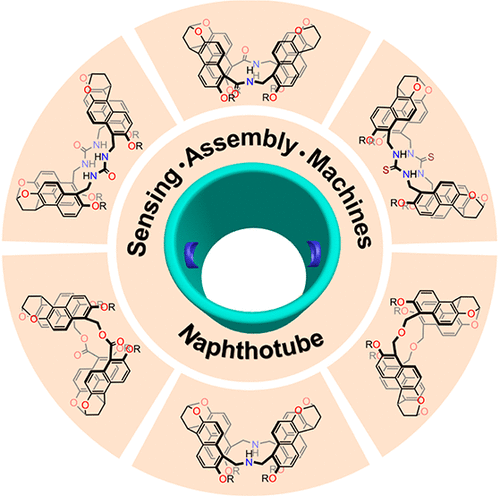当前位置:
X-MOL 学术
›
Acc. Chem. Res.
›
论文详情
Our official English website, www.x-mol.net, welcomes your
feedback! (Note: you will need to create a separate account there.)
Naphthotubes: Macrocyclic Hosts with a Biomimetic Cavity Feature.
Accounts of Chemical Research ( IF 16.4 ) Pub Date : 2019-12-20 , DOI: 10.1021/acs.accounts.9b00415 Liu-Pan Yang 1 , Xiaoping Wang 1 , Huan Yao 1 , Wei Jiang 1
Accounts of Chemical Research ( IF 16.4 ) Pub Date : 2019-12-20 , DOI: 10.1021/acs.accounts.9b00415 Liu-Pan Yang 1 , Xiaoping Wang 1 , Huan Yao 1 , Wei Jiang 1
Affiliation

|
Macrocyclic hosts are the principal tools used in supramolecular chemistry because they can recognize other small molecules through non-covalent interactions. However, in terms of recognition ability, known macrocyclic hosts are often not comparable to bioreceptors. This may be due to the lack of functional groups inside the deep cavity, which is a common feature of bioreceptors. Most of the known macrocyclic hosts contain either a hydrophobic cavity or polar binding sites only. Macrocyclic hosts with functional groups inside a hydrophobic cavity are rare. In 2004, Glass and co-workers reported a pair of water-soluble naphthalene-based molecular tubes with amide protons in the well-defined deep cavity. The cavity feature is very similar to that of bioreceptors. However, the amide protons were not used in molecular recognition and were replaced in 2012 with allyl groups in order to improve the hydrophobic effect. We started our work on the basis of the Glass molecular tubes but paid close attention to the functional groups in the deep cavity. In this Account, we summarize our results on these biomimetic receptors, which we call naphthotubes. The inward-directed functional groups endow the corresponding naphthotubes with unique recognition abilities. Naphthotubes with hydrogen-bond acceptors (ether, ester, and imine) prefer to bind organic cations; naphthotubes with hydrogen-bond donors (urea, thiourea, and amide) can bind neutral molecules; amine naphthotubes are stimuli-responsive to acid/base. In particular, the water-soluble amide naphthotubes are able to selectively recognize highly hydrophilic molecules in water-a generally accepted challenge in supramolecular chemistry. The unique recognition ability of these naphthotubes provides the basis for their applications in sensing, self-assembly, and molecular machines. Fluorescent sensing of environmental contaminants in water, chiroptical sensing of small chiral molecules, allosteric cooperative self-assembly, dissipative self-assembly, and directional molecular shuttles have been demonstrated with these naphthotubes. Overall, we hope to convey the message that these naphthotubes have unique recognition properties and promising applications in diverse fields. We believe that further exploration of this class of macrocycles may lead to practical applications in, for example, biomedical science, environmental science, and other related fields.
中文翻译:

Naphthotubes:具有仿生腔特征的大环宿主。
大环宿主是超分子化学中使用的主要工具,因为它们可以通过非共价相互作用识别其他小分子。然而,就识别能力而言,已知的大环宿主通常不能与生物受体相比。这可能是由于深腔内部缺少官能团,这是生物受体的共同特征。大多数已知的大环主体仅包含疏水腔或极性结合位点。在疏水腔内具有官能团的大环主体是罕见的。2004年,Glass及其同事报道了一对水溶性萘基分子管,在明确定义的深腔中带有酰胺质子。空腔特征与生物受体的特征非常相似。然而,酰胺质子未用于分子识别,2012年被烯丙基取代,以提高疏水作用。我们基于玻璃分子管开始我们的工作,但密切关注深腔中的官能团。在此帐户中,我们总结了在这些仿生受体(称为萘管)上的研究结果。向内的官能团赋予相应的萘管独特的识别能力。带有氢键受体(醚,酯和亚胺)的萘酚更倾向于结合有机阳离子。具有氢键供体(尿素,硫脲和酰胺)的萘管可以结合中性分子;胺萘管对酸/碱有刺激反应。特别是,水溶性酰胺萘管能够选择性识别水中的高度亲水性分子,这是超分子化学领域普遍接受的挑战。这些萘管的独特识别能力为它们在传感,自组装和分子机器中的应用奠定了基础。这些萘管已证明了对水中环境污染物的荧光传感,对手性小分子的手性传感,变构协作自组装,耗散自组装以及定向分子穿梭。总的来说,我们希望传达这样的信息,即这些萘管具有独特的识别特性,并且在各个领域都有着广阔的应用前景。我们认为,对此类大环化合物的进一步探索可能会导致在生物医学等领域的实际应用,
更新日期:2019-12-20
中文翻译:

Naphthotubes:具有仿生腔特征的大环宿主。
大环宿主是超分子化学中使用的主要工具,因为它们可以通过非共价相互作用识别其他小分子。然而,就识别能力而言,已知的大环宿主通常不能与生物受体相比。这可能是由于深腔内部缺少官能团,这是生物受体的共同特征。大多数已知的大环主体仅包含疏水腔或极性结合位点。在疏水腔内具有官能团的大环主体是罕见的。2004年,Glass及其同事报道了一对水溶性萘基分子管,在明确定义的深腔中带有酰胺质子。空腔特征与生物受体的特征非常相似。然而,酰胺质子未用于分子识别,2012年被烯丙基取代,以提高疏水作用。我们基于玻璃分子管开始我们的工作,但密切关注深腔中的官能团。在此帐户中,我们总结了在这些仿生受体(称为萘管)上的研究结果。向内的官能团赋予相应的萘管独特的识别能力。带有氢键受体(醚,酯和亚胺)的萘酚更倾向于结合有机阳离子。具有氢键供体(尿素,硫脲和酰胺)的萘管可以结合中性分子;胺萘管对酸/碱有刺激反应。特别是,水溶性酰胺萘管能够选择性识别水中的高度亲水性分子,这是超分子化学领域普遍接受的挑战。这些萘管的独特识别能力为它们在传感,自组装和分子机器中的应用奠定了基础。这些萘管已证明了对水中环境污染物的荧光传感,对手性小分子的手性传感,变构协作自组装,耗散自组装以及定向分子穿梭。总的来说,我们希望传达这样的信息,即这些萘管具有独特的识别特性,并且在各个领域都有着广阔的应用前景。我们认为,对此类大环化合物的进一步探索可能会导致在生物医学等领域的实际应用,











































 京公网安备 11010802027423号
京公网安备 11010802027423号